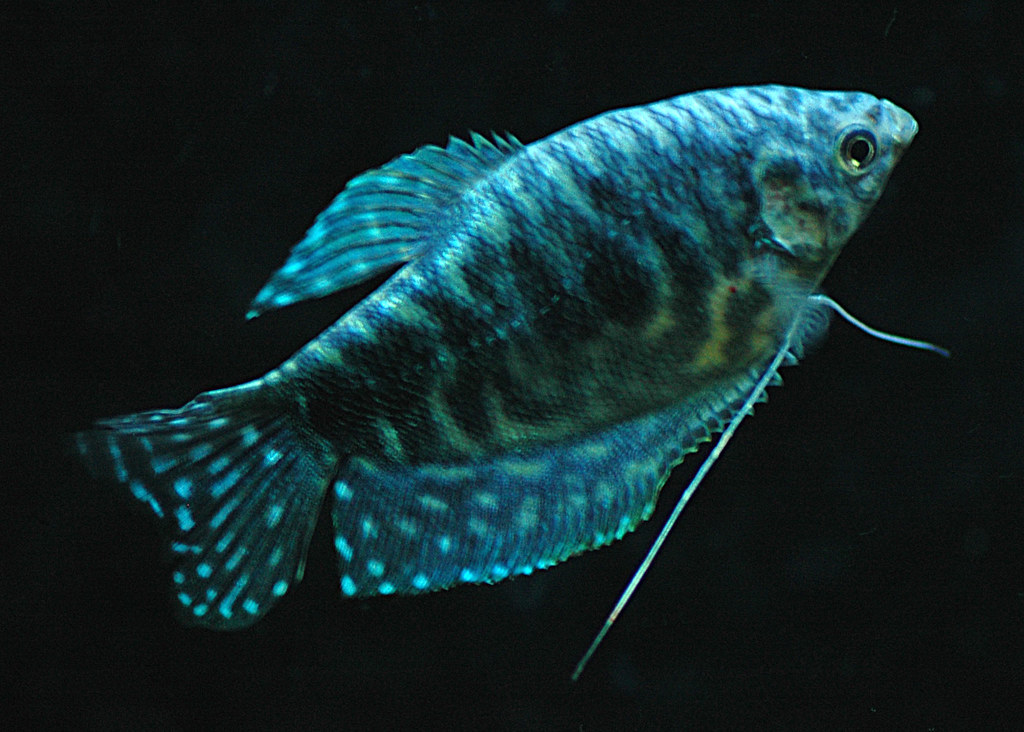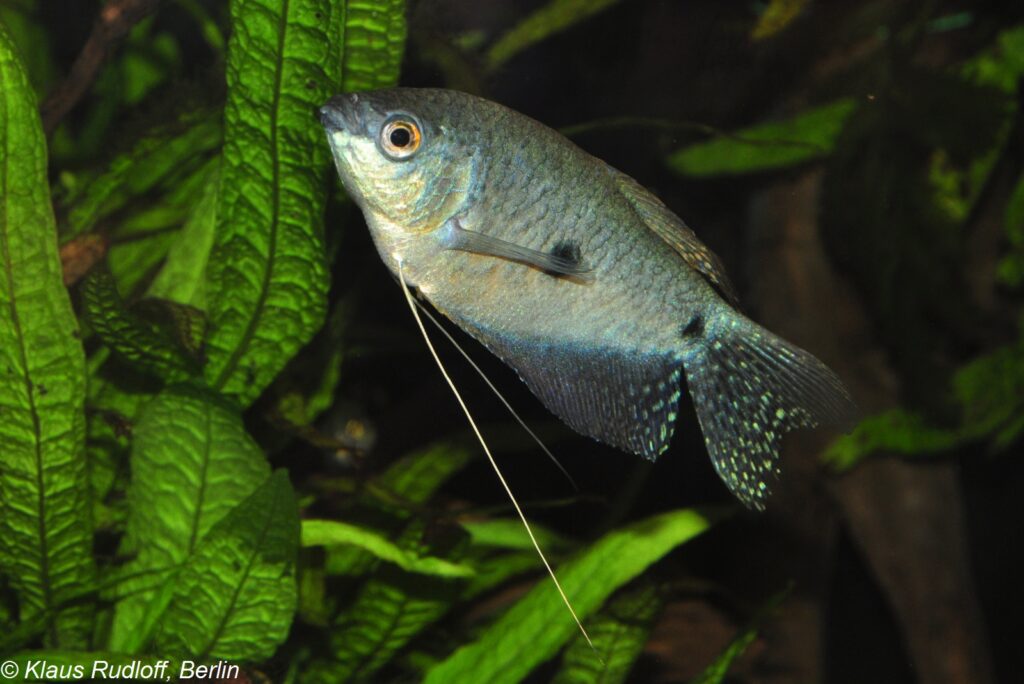Opaline Gourami
The splendid and adaptable Opaline Gourami – Trichopodus trichopterus, also referred to as three spot gourami, is a remarkable selection for your home aquarium. Their unique features, charming looks, and vital vitality make them popular among fish enthusiasts. These active aquatic fellows are notably uncomplicated to care for, making them an ideal choice for novice aquarists. It’s essential, though, to understand the necessary care tips before bringing these stunning creatures home from the pet store.
- Experience Level: Beginner
- Hardiness: Hardy
- Minimum Tank Size: 20 gal (75 L)
- Maximum Size: 8 inches (20 cm)
- Temperament: Peaceful
- Temperature: 73 – 82° F (23 – 28° C)
- pH Range: 6 – 8.5
- Water Hardness: 5 – 35 dGH
- Diet: Omnivore
Table of Contents
Introduction
Size and Appearance
Care Guide
Tank Mates
Diet and Feeding
Breeding
Opaline Gourami, scientifically called Trichopodus trichopterus, is a visually fascinating aquatic species, with alternate names like Marble Gourami reflecting their undulating silver-blue hues. Some fish experts also identify them as three-spot Gourami due to their distinctive bi-chromatic arrangement.
Bred through selective procedures, these fish hail from Southeast Asia, inhabiting the marshlands and wetlands across Cambodia, India, the Philippines, and Malaysia.
Size and Appearance
All Opaline Gouramis share a typical Gourami shape with an oval form and elongated anal fins that run from beneath the pectoral fins to the tail fins. They are recognized for their slender ventral fins that resemble antennas, functioning as touch-sensitive appendages critical for navigation.
The shades adorning Opaline Gouramis are captivating. They’re impressed with a silver-blue base color along with patches of dark blue that create a distinctive marbled look. Each of these fish presents a slightly different pattern, offering various designs within the species. This variance allows aquarists to handpick the most dazzling specimens to enhance their aquarium aesthetics.
The average size of a fully matured Opaline Gourami is nearly 6 inches, with most reaching their maturity around the 3-inch mark. The final size of each individual fish depends both on its genetic makeup and the care it receives.
Identifying Male and Female Opaline Gourami
Separating male and female Opaline Gouramis can be tricky as their physical appearance is strikingly similar. One tip is to observe the dorsal fins: males have elongated, pointed ones, while females have shorter, rounded ones. Additionally, males are generally leaner, while females sport a more curved belly.
Care Guide
- Minimum Tank Size: 20 gal (75 L)
- pH Range: 6 – 8.5
- Water Hardness: 5 – 35 dGH
- Temperature: 72 – 82° F (23 – 28° C)
- Lighting: Moderate, diffused lighting
- Substrate: Fine sand/gravel
- Brackish: No
- Water Flow: Weak/Low
- Tank Region: All areas
While Opaline Gourami is beginner-friendly, it’s crucial to understand their specific needs and preferences, as all freshwater fish species have distinct living conditions.
The aquarium environment significantly influences the well-being of your Opaline Gourami. Aim to create an environment that closely resembles their natural habitat, focusing on maintaining optimal water conditions and cleanliness.
A single adult Opaline Gourami prefers an aquarium of at least 35 gallons, allowing them ample swimming space. Juvenile Opaline Gourami can thrive in smaller tanks starting at 20 gallons, but as they grow, their playfulness and swimming tendencies demand larger habitats.
After establishing an adequate tank size, it’s important to focus on getting the right water parameters. To do this, consider the typical living conditions in the fish’s natural habitats, which are warm, shallow waters with abundant plant life leading to moderate hardness and slight acidity. Thankfully, these fish are resilient and can tolerate slight variations in these conditions.
Opaline Gourami don’t have particular lighting requirements, so it’s usually best to adapt the lighting for the other types of fish in the tank.
Opaline Gourami aren’t picky regarding their surroundings. Think about choosing decorations that not only elevate their appearance but also accommodate their lifestyle. A dark substrate often enhances their unique colors. You can choose from fine sand to pebbles – they aren’t fussy.
Filling their tanks with plants can make them feel at home, as their natural environments are densely vegetated. However, careful spacing is required to ensure that sufficient swimming space remains available.
While Opaline Gouramis usually display peaceful coexistence, confining them in smaller tanks can spark aggressive tendencies. As they age, juveniles that were formerly peaceful might show increasing territoriality and hostility, especially among males.
During the daytime, Opaline Gouramis make an interesting spectacle. They possess a unique labyrinth organ enabling them to gulp air directly from the atmosphere, prompting regular visits to the water’s surface. When not breathing, they exhibit playful swimming and exploration behaviors.
Since these species enjoy swimming near the surface, avoid crowding the tank with plants. Despite some incidents of aggression in mature fishes, Opaline Gouramis generally remain gentle, delightful pets.
Tank Mates
Selecting the appropriate tank mates for your Opaline Gourami is crucial to ensure their well-being. Their gentle nature often makes them targets for aggressive fishes. Hence, they should not be housed with known fin-nippers, overly aggressive species like Firemouth cichlids, overly large species, or fish small enough to fit into their mouths.
Consider the below species known to cohabit peacefully with Opaline Gouramis:
- Plecos
- Peaceful Barbs
- Large Tetras
- Loaches
- Characins
- Large snails and shrimps
- Angelfish
- Corydoras Catfish
Feeding Guide
- Diet: Omnivore
- Frequency: Several small feedings per day
- Pellet Foods: Yes
- Flake Foods: Yes
- Live Foods: Yes
- Meat Foods: Yes
- Vegetable Foods: Yes, will often take partly cooked, dark leafy greens
Opaline Gouramis, being omnivorous, readily accept a variety of both meat-based and plant-based foods. A balanced diet should include high-quality pellets or flakes for tropical fish species supplemented with additional live, frozen, or dried foods. Live or frozen rice worms, micro worms, tubifex worms, fresh vegetables, and algae flakes provide a wholesome, nourishing diet.
Breeding
Breeding Opaline Gouramis requires some knowledge and preparation. First and foremost, differentiate between the sexes, a challenging task until they mature. Buying a mixed group from the pet store and letting natural pairings unfold is advised. Once selected pairs are formed, transfer them to a specially-prepared breeding tank.
The breeding tank should be around 20 gallons with floating plants and shallow water. To condition the water, use peat filtration, and install sponge filters to safeguard the fry upon hatching. A mildly warmer temperature of about 80 F, along with a neutral to acidic pH and somewhat softer water consistency, often stimulates spawning.
The absence of an air stone is beneficial, as males appreciate calmer waters for nest building. Once the females lay the eggs, the males guard them fiercely. To prevent potential harm to the female, it’s best to remove her from the tank.
Once hatched and mobile, the young can be fed infusoria or alternatives like brine shrimp, blood worms, micro worms, powdered food, or crushed flake food.



